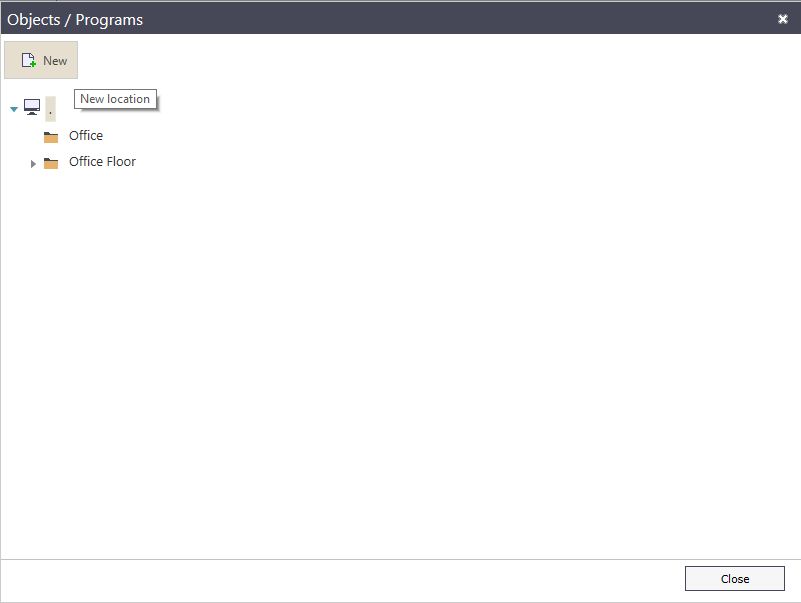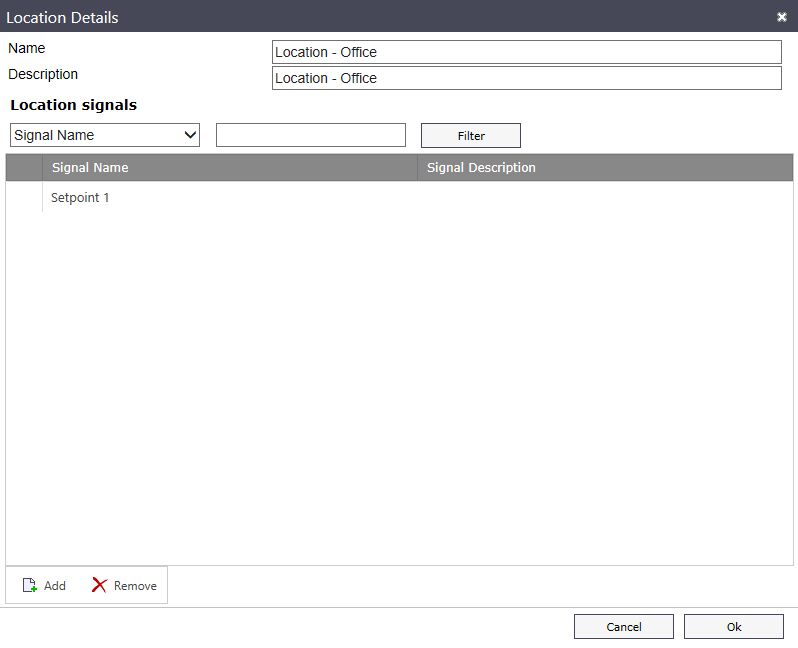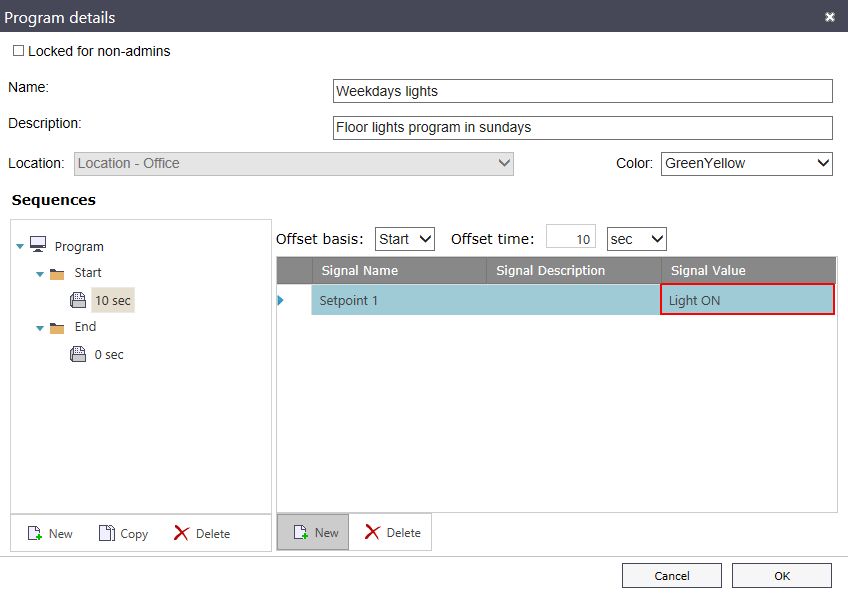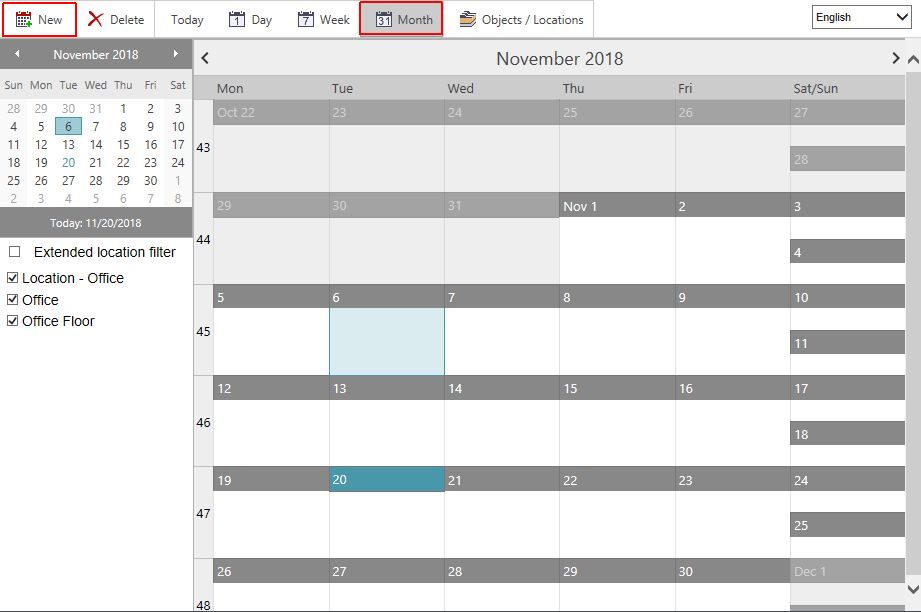SchedulerPro Tutorials
Relieve your employees of simple tasks by configuring the SchedulerPro module. Check out these articles to build better and more successful installations.
Note
The SchedulerPro tutorials use the Demo Database of Studio project and the signals associated with it.
Create location
The first step in using SchedulerPro is by defining a Location, which represents the location of the controlled device(s).
The first step in using SchedulerPro is by defining a Location, which represents the location of the controlled device(s). The device's signal is attached to the Location.
Tip
For example, the signal controlling the lights in the office is attached to the office location.
To set up a Location in SchedulerPro, organize the following steps:
Open the SchedulerPro from the Settings section of the i4scada Studio.

While in SchedulerPro, click on the Objects/Locations button from the main menu (toolbar).

In the Objects / Programs window, click the New button.

The Location Details window pops-up.
In the Location Details window, fill in the Name and Description of the location. Further on, click on the Add button.

In the Signal browser dialog, expand the tree structure on the left side. The signal defined as Module signal for SchedulerPro will be available. Select the signal and click the Add button.

The module signal is now attached to our Office location. Confirm the Location Details window by pressing the Ok button.

The new location is now available in the Objects / Programs window.

Create program for location
Learn how to manipulate the SchedulerPro module signal's value in relation to the start and end of the program, by associating a Program to a Location.
Now that the Location is defined, we need to create a Program associated with this location. The Program will allow us to manipulate the module signal's value in relation to the start and end of the program.
Tip
For example, the signal value can be set to 0 seconds when the program starts and to 1-10 seconds, before the program ends.
To set up the Program, follow the next steps:
In the Objects / Programs window, select the Location and click the button New from the program section of the menu. The Program details window is opened.

In the Program details window, fill in the Name and Description of the program. The location is already set, so choose a color using the Color drop-down menu.

Now we need to define the actual program for our signal. The program is based on sequences (left panel). The Start marker already has a default sequence (0 sec). The sequences are relative to the Start and End markers of the program and the relations with these markers are expressed in seconds or minutes.
For example, the 20 seconds sequence under the Start marker will be triggered after 20 seconds, after the program started. In a similar way, the 20 sec sequence under the End marker will be triggered 20 seconds before the program ends.
Select the default 0 sec sequence and adjust the Offset time to 10 seconds, so the sequence will start after 10 seconds since the program starts. Click on the New button from the bottom of the right panel to add the signal.

In the Signal browser dialog, select the signal and click Add to add it to the sequence.

Back in the Program details window, double-click the Signal Value field and type the value 1, corresponding to the Lights ON discrete value. The Signal Value field will display the Lights ON discrete value.

Now, to the lights to be switched off when the program ends, we need to create a new sequence under the End marker. Select the End marker from the left side panel and click the New button from the bottom of the panel.

Select the new sequence and adjust its Offset time to 1 minute, thus making the lights go off a minute before the program ends. Click the New button from the bottom of the right side panel to add the signal to this sequence.

In the Signal browser, select the signal and add it to the sequence. Double-click the Signal Value field and enter the value 0, corresponding to the Lights OFF discrete value.

Now the program is defined and it will turn the lights on, after 10 seconds since it starts, and will turn the lights off a minute before it ends. Click the OK button to confirm the program. The program will be displayed in the Objects / Programs window, under the Office floor location.

Schedule an event to trigger the program
Learn how to use the SchedulerPro calendar interface to schedule the Program to run every day of the week, except for the weekend.
Now that we have the Location and Program defined, we will use the SchedulerPro calendar interface to schedule the Program to run every day of the week, except for the weekend.
Follow the next steps to schedule the Program:
From the SchedulerPro menu, select the Month view, to have a better view of our schedule. Click on the New button from the main menu.

The Event details window is opened. Enter the Name and Description of the event. Set the Event time to start at 8 AM and end at 8 PM.

Set the Recurrence pattern to Weekly. Mark the event to take place every week (Every 1 week) and select the weekdays.

As we want our program to be scheduled indefinitely, select No end date in the Range of recurrence section and select the start date.

Next, we must associate a Program with this planned event. In the Event details window, click on the Program tab and on the Associate button.

In the Event-program association dialog, select the Weekdays lights program from the Office floor location and click OK to associate it to our event.

The Event details window will display the selected program for this Event. Click OK to confirm the Event.

The new Event will be listed for each planned day in the SchedulerPro calendar view.

Create exceptions and adjustments
The scheduled event might be interrupted by holidays, so go ahead and schedule an exception and an adjustment, for these interruptions.
The scheduled event might be interrupted by holidays, so in order to adapt the event to these interruptions, we are going to schedule an exception and an adjustment for two holiday scenarios.
Create an exception
Right-click on the event displayed in the SchedulerPro calendar view and select the Edit event option.

SchedulerPro allows the user to either edit the occurrence or edit the entire series. As we want to edit the event as a whole and not only one occurrence of the event, choose the Open the series option and click the OK button to proceed.

In the Event details window, click on the Exception tab. Click the New button from the Series exceptions section.

In the Day selection dialog, select the day when the program should not be active (the holiday) and click OK.

The exception day is now visible in the Series exceptions list. Confirm the Event details window by pressing the OK button.
In the SchedulerPro calendar view, the exception day is now free of the planned event.
Create an adjustment
Right-click on the event displayed in the SchedulerPro calendar view and select the Edit event option.

The SchedulerPro allows the user to either edit the occurrence or edit the entire series. As we want to edit the event as a whole and not only one occurrence of the event, choose Open the series and click the OK button to proceed.

In the Event details window, click on the Exception tab. Click the New button from the Series adjustments section.

In the Day selection dialog, select the day in which the Event should be adjusted. Click the OK button to proceed.

In the Series adjustments details window, we can adjust either the Event time or select another associated Program to run in the selected day. For this example, we will adjust the Event time so that our planned Event will stop earlier. Press the OK button to confirm the adjustments.

The new adjustment is now listed in the Series adjustments list. Press the OK button to confirm the changes.

In SchedulerPro calendar view, the adjusted date will display its new program.
